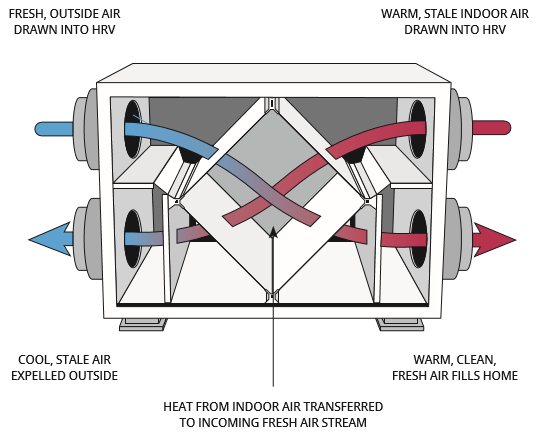Simple Tips to Maximize HRV Performance
Checking out the Benefits of Heat Recovery Ventilation for Energy Efficiency in Homes
Heat Recovery Ventilation (HRV) systems use home owners a useful strategy to boosting power performance. By recovering warmth from outgoing air, these systems can significantly decrease cooling and heating prices. In addition, they supply a stable supply of fresh air, improving interior air high quality and convenience levels. As homeowners take into consideration sustainable alternatives, recognizing the nuances of HRV systems comes to be significantly vital. What elements should one evaluate before making such an investment?
Comprehending Heat Recovery Ventilation Solutions

Just How HRV Improves Indoor Air Quality

Power Financial Savings: The Economic Benefits of HRV
Making best use of power performance, heat recovery ventilation (HRV) systems use substantial financial advantages for homeowners. By recovering and reusing heat from exhaust air, HRVs significantly reduce heating & cooling costs. This innovation can cause power savings of up to 30%, depending on climate and usage patterns. Homeowners often notice decreased utility costs quickly after installment, making HRVs an economically wise financial investment over time. Furthermore, numerous regions provide incentives or discounts for energy-efficient upgrades, even more enhancing the monetary allure. As power prices remain to climb, the cost-effectiveness of HRVs comes to be increasingly clear. On the whole, the incorporation of HRV systems not only promotes energy performance however also adds to long-term financial savings for houses.
The Ecological Influence of Heat Recovery Ventilation
A significant ecological advantage of heat recovery ventilation (HRV) systems exists in their capability to reduce general power consumption. By recovering warm from exhaust air and moving it to incoming fresh air, HRV systems lessen the demand for energy-intensive heating and cooling approaches. This decrease in power need adds to lower greenhouse gas emissions, as less fossil gas is called for to maintain comfy indoor temperature levels. Additionally, HRV systems boost indoor air high quality by efficiently trading stagnant air with fresh outdoor air, lowering reliance on mechanical air conditioning systems that can hurt the environment. Overall, the application of HRV systems sustains sustainable living practices and aligns with worldwide efforts to battle environment adjustment by promoting energy efficiency in property settings.
Picking the Right HRV System for Your Home
How can homeowners guarantee they choose the ideal heat recovery ventilation (HRV) system for their requirements? They must assess their home's size and layout, as these aspects influence air movement requirements. Next, reviewing the system's performance ratings is vital, as higher scores indicate read more better efficiency and energy savings. House owners need to additionally think about installation and maintenance costs, contrasting different brands and designs for value. Additionally, it's crucial to assess noise levels, as some systems run more silently than others. Consulting with HVAC specialists can offer customized recommendations based on specific home conditions. Lastly, examining user evaluations and guarantees can assist in making site web an educated choice, ensuring that the picked HRV system successfully enhances interior air top quality and power performance.
Frequently Asked Concerns

Just how Commonly Should I Clean or Keep My HRV System?
The frequency of cleaning or maintaining a heat recuperation air flow (HRV) system typically depends upon use and environmental factors. Typically, it is recommended to perform maintenance every 6 months to ensure peak efficiency and air top quality.

Can HRV Solutions Help In Reducing Moisture Levels Inside?
HRV systems can successfully decrease indoor humidity levels by exchanging stale, moist air with fresh, drier air from outdoors. HRV Heat Recovery Ventilation. This procedure helps maintain a well balanced interior environment, enhancing convenience and stopping moisture-related issues
What Is the Life-span of a Common HRV System?
The life expectancy of a normal heat recovery ventilation (HRV) system varies, normally lasting in between 10 to 15 years. Normal maintenance can prolong its performance and operational life, making certain peak efficiency throughout its use duration.
Are There Any Kind Of Sound Concerns With HRV Systems?
Sound worry about HRV systems can occur, specifically from fan operation. Nevertheless, lots of modern-day units are designed to reduce audio levels, ensuring they operate quietly while maintaining efficiency, which resolves potential disruptions in living environments.
Can I Set Up an HRV System Myself, or Do I Need a Specialist?
The specific contemplated whether to install the heat recovery ventilation (HRV) system personally or work with a professional. Usually, while company website do it yourself installation is possible, competence assurances appropriate capability and conformity with regional building ordinance, improving system effectiveness.